
Boating Basics Online is reader-supported. When you buy via our links, we may earn a commission at no cost to you. Learn more

How to Paint a Sailboat? – A Step-by-Step Guide
Written by J. Harvey / Fact checked by S. Numbers

Painting a sailboat hull not only lets you save money, but it can also be quite gratifying. Plus, learning how to paint a sailboat can be likened to taking that one important step of truly claiming your vessel as your own. I mean, they’re our darlings, right?
This simple guide teaches you how to paint the hull of a boat, including a sailboat’s. Overall, it’s not hard to grasp – just a bit tiring, and plenty of waiting is involved.
Table of Contents
Prepare the Following
Step 1. give the sailboat a thorough cleaning., step 2. start sanding the hull’s surface., step 3. prepare the primer, then apply it., step 4. prepare the paint, then start applying the topcoat and antifouling coat., the importance of painting your sailboat, how often do i need to paint my sailboat, some best paints to use for a sailboat, safety tips for painting.
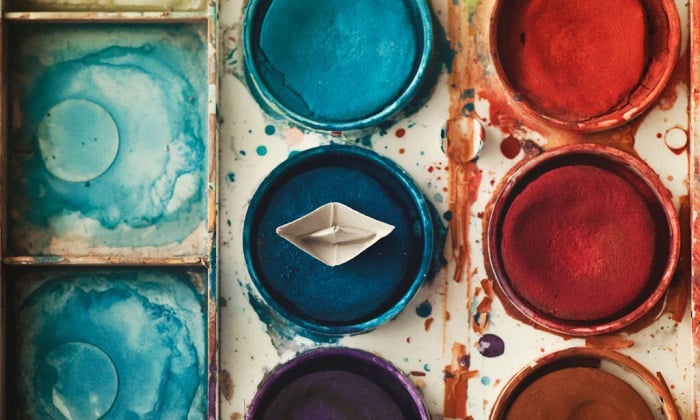
- Marine-grade paint
- Primer (epoxy recommended) and hardener
- Sandpaper (80-grit, 220-grit, and 400 grit)
- Cleaning cloth
- Masking tape
- Roller (or paint sprayer)
- PPEs such as gloves, a coat, and a respirator
Choose a workspace with good ventilation to avoid exposing yourself to fumes, which have many detrimental but highly avoidable side effects. Painting the boat on its trailer on a clear, dry day and positioning it so the paint won’t get direct sunlight exposure are ideal.
Practical Steps for Painting a Sailboat
This guide works well for fresh paint jobs and even if you’re repainting the boat.

Any dirt, debris, and grease should be taken care of in any sailboat paint job. Check for debris and algae clinging to the hull and the sailboat deck, and just use the brush and cloth to get it off.
Double-check parts of the keel because mud and seaweed tend to stick to it the most. If there are barnacles present, you may have to power wash them or any stubborn green stuff you encounter.
Dip the sponge in a mix of boat soap and water, then start scrubbing any stains. Afterward, give the sailboat a good rinse. Wait for it to dry.
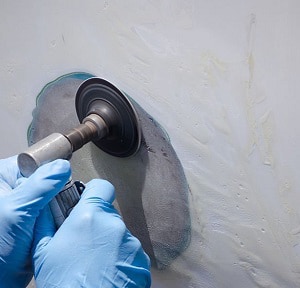
Put on your respirator and coat. Use an 80-grit or 100-grit to roughen the surface and remove any lingering trace of old paint by scrubbing in circular motions.
Then, grab the 220-grit to smoothen the surface more. That said, an 80-grit or 40-grit paired with a sander will do just as well, based on my experience every time I repaint a fiberglass boat .
You’d want the surface to be as even and smooth as possible before applying the first coat.

The epoxy primer helps to ensure that the paint will adhere well, too, so I recommend you don’t skip it. Epoxy also acts as a good sealant and prevents cracking and rust.
Before you apply it, put some masking tape over the areas of the hull that you don’t want the coats to go over. It will ensure even coats, too.
Every epoxy primer and hardener combination is different in one way or another. As such, follow what the manufacturer recommends when mixing. Be mindful of how quickly the mixture hardens.
Once you’re done with that step, use the roller to apply even coats of it over the whole surface of the hull. Depending on the size of your boat, this may take a while and can be tiring, so I suggest you ask for help.
Done? It’s time to wait a day to apply another layer. The next day, you can either apply another coat of primer (up to 4 coats is great) or proceed to the painting part.

Mix the paints according to the instructions.
You need to make sure the primer has dried before painting. I suggest two layers of topcoat followed by two equal coats of antifouling paint. But you can also skip to the antifouling paint immediately – your boat, your choice.
- Be sure to pick a good marine-grade paint like TotalBoat’s Alumipaint AF or Interlux’s Fiberglass Bottomkote Aqua. Better yet, you can just head to your local marine shop and ask for recommendations (trust me, they know their sailboat paint best).
- We’re not exactly doing something artsy here, like making an easy sailboat painting with acrylics. You want coats that can take a beating, so choose marine grade only.
Once you’re ready to work, use a roller or a sprayer to apply the paint. Personally, I’d suggest the latter choice because if you spray paint a boat, you’ll get a sleeker, more attractive finish, although it requires some skills.
Therefore, if you’ve never handled a sprayer, the best way to paint a boat would be with a roller. Here are some tips to ensure the best results:
- Pour the paint into the t
- Slightly dampen the roller with clean water.
- Lightly dip the roller into the paint so that no more than half of it is submerged.
- Run the roller on the paint tray’s ramp a few times to evenly distribute the pigment.
- Run the roller from the top to the bottom of the hull. Make sure you apply even pressure as you do so. Remember: the strokes should be parallel and uniform; under no circumstance should you change the stroke to a different pattern.
- Use a paintbrush to access cavities and holes on the hull that your roller can’t reach.
- Apply the suggested number of coats for each type of paint, taking care to sand with the 400-grit or higher with each However, make sure you confirm that it’s recommended by the paint’s manufacturer.

- The first is aesthetics. How can your gaze possibly not be arrested by an exquisitely painted sailboat sailing in the distance? It’s an automatic postcard image.
- Secondly but just as important (if not more), you’re protecting your baby from damage, barnacles, rot, and other nasty things, extending its life and boosting its value.
- It exercises your creativity. Try out some sailboat paint schemes available on sites like Pinterest, and you’ll know what I’m talking about.
I’ve certainly tried one or two of these ideas myself, but not on a skiff and jon boat that I made from scratch. My wife and buddies were positively mesmerized.
- Much like how videos on YouTube showing easy boat acrylic painting puts my mind at ease, I can say the same for when I’m painting sailboat hulls.
A lot of my friends who love to sail, fish, and paint sailboats on canvas say the same since they’re often more than willing to stop by and lend a helping hand during my paint days. We exchange sailboat painting ideas occasionally, and they like the method I’ve shared here.
As such, painting boats can be a way to relax your mind and help you connect with like-minded people. You may also learn helpful tips regarding sailing and boat maintenance along the way.
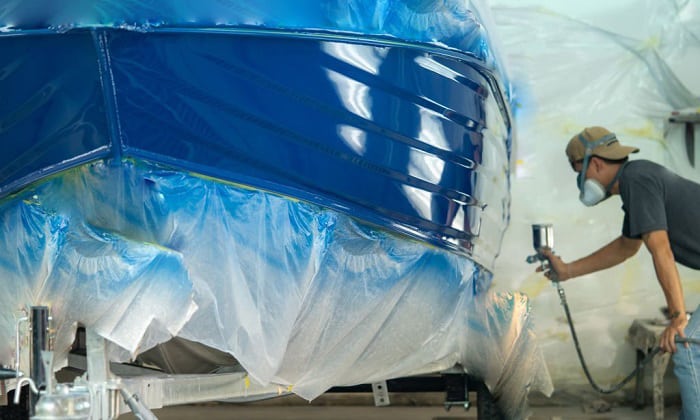
You need to paint your boat every year if you let it sit in the water all the time and the vessel shows signs of degradation.
That said, if you paint your sailboat with high-quality products, such as marine-grade paint, the coating can last for as long as 10 years, especially if you’re extra careful with your boat and have proper storage for it.
Besides the two brands I mentioned above, you can also try antifouling paints by Rust-Oleum. I just rotated between TotalBoat, Rust-Oleum, and Interlux because these three provided the best results among the sailboat paints I tested.
Rust-Oleum’s Topside Paint paired with the brand’s fiberglass primer work well with fiberglass hulls. But I can say the same for TotalBoat’s Topside Paint. To me, it’s really just whichever of the three is available on my local marine shop’s shelf. Besides choosing the right paint, you may also ask yourself how much it costs to paint a boat. Is it worth it? Check out this article to get the answer!

If you follow most of the preliminary preparatory steps I’ve shared here, you will be keeping yourself safe from start to finish.
- Wear the PPEs I said above every time you’re sanding and applying epoxy and paint on the surface.
- Read any warning labels on the paint and other chemicals you use, like acetone for drying the paint quickly. Handle it with care always.
- Learn how to dispose of your paint properly. It’d be even better if you learned how to recycle it.
- Beware of accidents that may happen while you’re doing the cleaning and prep work. I mean, I’ve hit my head on a sailboat mast while doing them, so I reckon the chance of such misfortunes happening isn’t zero, even on a paint job.
To recap everything I’ve said regarding how to paint a sailboat:
- Position your boat in a good workplace.
- Clean and sand its hull well using boat soap and water and sandpaper.
- Apply 4 coats of the primer, 2 coats of the topcoat, then 2 antifouling coats, or skip to the antifouling paint coat immediately.
- Decide how you’re going to apply the paint based on the finish you want and your skill in using each tool.
We wish you the best of luck with your painting project. If you want to share your results with us, feel free to reach out via the comment below.

“My intention from the first day establishing Boating Basics Online is to provide as much help as possible for boaters who want to experience a first safe and convenient trip. So feel free to join us and share your beautiful journeys to the sea!”
Free Challenge!
The creative recovery.
Join my FREE 5-day challenge starting March 19, 2024 to boost inspiration and create more passion and alignment in your work!
Say no more, sign me up!
march 19-23, 2024

Jenna Rainey
My supplies

CEO + ARTIST + EDUCATOR

hey friend!
I’m jenna rainey. , i'm an artist, self-taught designer, and multi-faceted creative entrepreneur who is hell-bent on teaching everyone how to find their inner creative voice..
My favorite supplies
A highly creative nerd with a unique breed of humor and the proud earner of a self-bestowed award for being the world’s most curious and driven human.

Hey I'm Jenna!
Hang out on youtube, it’s like netflix-binging bob ross videos, but with a dose of dry + quirky humor and fewer happy little tree references. .

Wanna Learn Watercolor ?
i wrote some books

DEVELOP YOUR ARTISTIC STYLE
GRAB THE FREE GUIDE

Watercolor Sailboat
Jenna .
This week, I'm teaching you how to paint a quick and easy watercolor sailboat landscape!
When I don't have a lot of time or I just want to play with colors and basic shapes, I paint loose-style. It's just whimsical and fun!
This watercolor sailboat takes less than 10 minutes to paint but includes simple techniques to inspire and spark creativity. This is a great tutorial for beginners, too!
Watercolor Sailboat Step by Step
00:00 – Intro. 00:32 – Color mixing. 01:06 – Painting the sail boat. 02:16 – Painting waves. 03:01 – Painting trees and background. 04:53 – Painting the sky. 06:14 – My thoughts on the painting. 06:51 – YOUR thoughts?
Links & Freebies
Get access to all my favorite art supplies and business tools here. My Amazon storefront with supplies and other random things I love. My Spotify painting playlist My Floral Watercolor E-book My Calligraphy E-book
Related videos
Complete Beginner's Guide to Watercolor Complete Beginner's Guide to Watercolor: Top Questions Answered Complete Beginner's Guide to Watercolor Flowers Watercolor Techniques: Wet-on-Wet Watercolor Techniques: Wet-on-Dry 10 Tips to Improve Watercolor
… and for even more tutorials, subscribe to my YouTube channel!
Patreon Community
Join my Patreon community! You have a variety of fun options to choose from like:
- Watch my YouTube tutorials ad-free
- Get early access to the tutorials before they're released on YouTube
- Patreon-exclusive tutorials
Head on over to Patreon to get all the fun details.
by Jenna Rainey
+ show Comments
- Hide Comments
add a comment
Leave a Reply Cancel reply
Your email address will not be published. Required fields are marked *

Browse By Category
art + creativity
So Hot Right Now
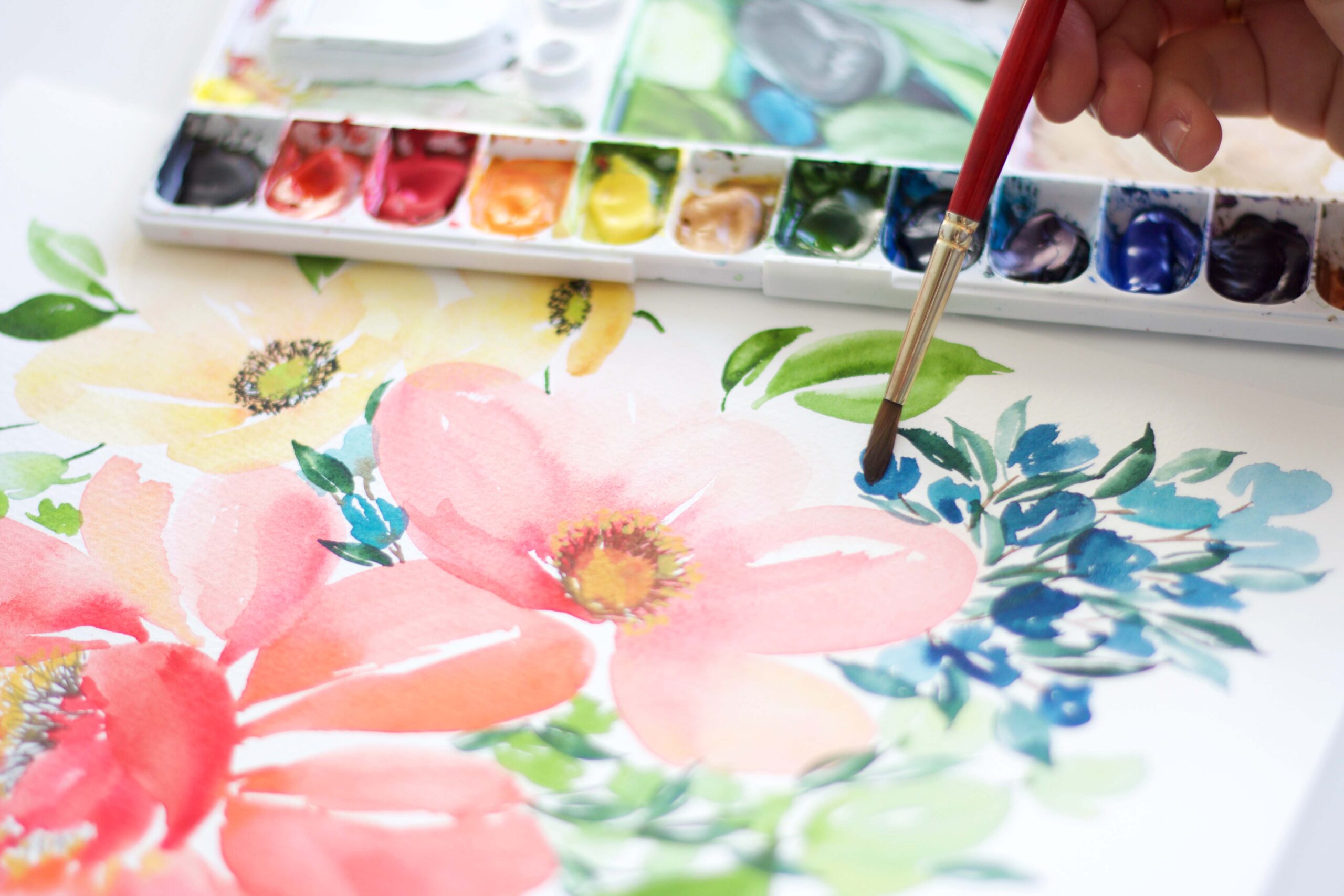
The Best Watercolor Tutorials For Beginners

How to Avoid Shiny Object Syndrome as a Creative Entrepreneur

Social Media
Growing Your Business On Social Media in 2024
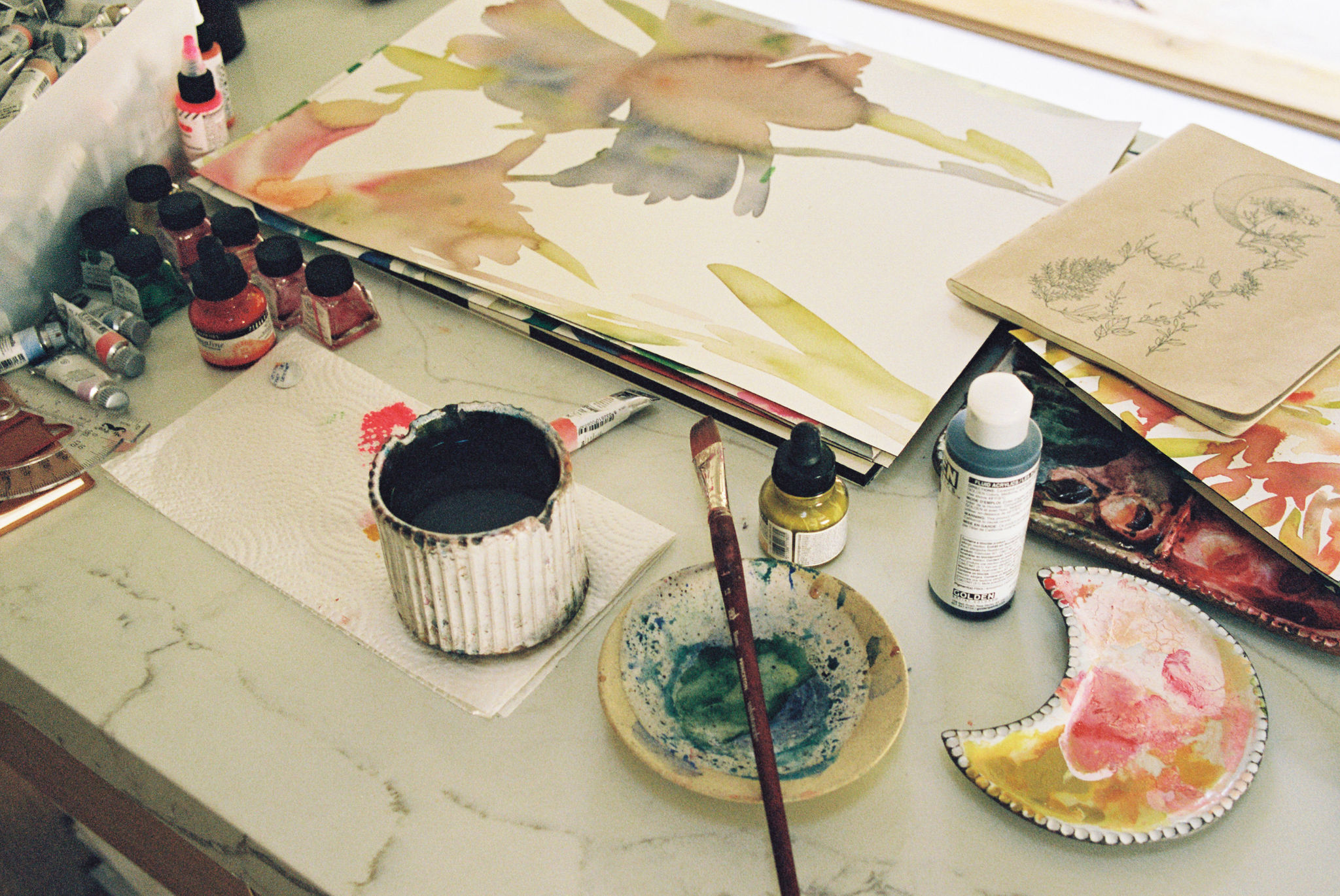
Is Social Media Making Your Art Bad?

10 Unconventional Methods to Spark Your Artistic Inspiration

Business Resources
A Step-by-Step Guide to Creating a Business Plan for Your Small Creative Business
back to blog home
Previous Post
« How to Map Out Your Content Calendar
“Should I Have a Blog?” Reasons Why Blogs Are Important »

The Complete Beginner's Guide to Watercolor
Get a rundown of all my recommended supplies, learn fundamental techniques and tips including color theory and composition, and walk away feeling super confident with your new love of watercolor!
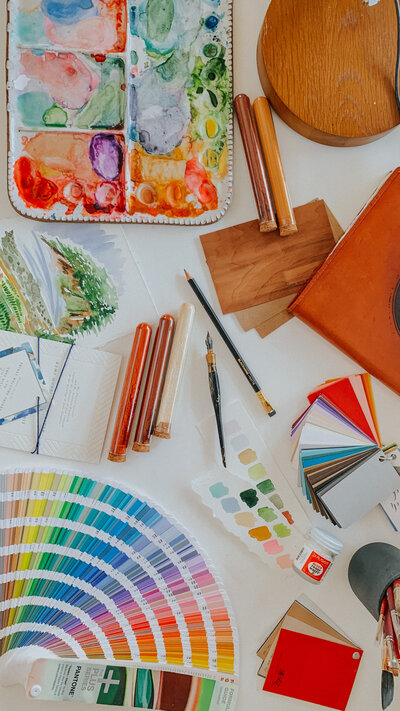
Free e-book
Freebie Alert!
*signing up will subscribe you to our email list, you may unsubscribe at any time, though doing so means we cannot contact you with more free, valuable education and tips on this topic. you also agree to our terms and conditions and privacy policy ., an artist, self-taught designer, and multi-faceted creative entrepreneur who is hell-bent on teaching everyone how to find their inner creative voice., i'm jenna rainey..

Customer Support
YOU'VE GOT MAIL!
back to the top

Read the blog
watch me on youtube
my art community
art retreats
everyday watercolor books
licensing resources + tips
The Ceo advice column
Customer service
program login
community login
contact us!
© 2018-2024 JENNA RAINEY LLC | TERMS & CONDITIONS | PRIVACY POLICY | SITE CREDIT

@JENNARAINEY

- Butterflies
- Art Business
- Art History
- Art Schools
- Artwork from Life
- Calligraphy
- Classical Art
- Color Theory
- Colored Pencil
- Composition & Design
- Digital Art
- Drawing & Sketching
- Egg Tempera
- Fantasy Art
- Figure drawing
- Figure Models
- Illustration
- Oil Painting
- Paint Along With Skye
- Pen & Ink
- Underpainting Technique
Sailboat Acrylic Painting Tutorial using Palette Knife
Audible Free 30-day Trial: http://www.audible.com/angelafineart Learn to paint a simple sailboat seascape with palette knives in this acrylic painting tutorial by Angela Anderson. Easy and fun lesson using palette knives to create a modern nautical canvas.
Materials Used: Heavy Body Acrylic Paints: http://goo.gl/r9mZPZ Titanium White Carbon Black Burnt Sienna Ultramarine Blue Cerulean Blue Phthalo Blue Teal Cadmium Yellow Medium Cadmium Red Medium Unbleached Titanium Acrylic Synthetic Brushes from The Brush Guys: http://bit.ly/angelafineartbrushes 5% discount code: “angelafineart” ITALY PAINT KNIFE 1-5/8 X 3/8 ITALY PAINT KNIFE 3-1/4 X 1/2 RYAN ITALY PAINT KNIFE Loew Cornell 3 inch Painting Knife
You can help support this channel on Patreon and receive traceables and other exclusive rewards here: https://www.patreon.com/angelafineart
Please subscribe https://www.youtube.com/subscription_center?add_user=angelafineart and give a thumbs up if you enjoyed this video. Thank you for watching!
Social Media Contacts: Patreon: https://www.patreon.com/angelafineart Email: [email protected] (send photos here or facebook) My Website: http://www.angelaandersonfineart.com/ Google +: https://plus.google.com/+angelafineart Facebook: https://www.facebook.com/angelaandersonfineart Thankful Art Group: https://www.facebook.com/groups/thankfulart Angelooney: https://www.facebook.com/groups/AngelooneyWinterPaintIn My Blog: http://angelaandersonart.blogspot.com/ Pinterest: https://www.pinterest.com/angelafineart/ Twitter: https://twitter.com/angelafineart Instagram: https://instagram.com/thankfulart Snail Mail: P.O. Box 12171, Russellville, AR 72812 (I’d love to hear from you!)
Copyright info: Videos produced by Angela Anderson (angelafineart) are intended for private use only by non-profit community, home and school groups. Please contact me for commercial/retail use licensing information. Feel free to embed the videos as is, but please do not alter, remove watermarks, re-upload or otherwise change the original video. Thank you.

How To Paint a Seascape – Samuel Earp Artist

Seascape Oil Painting Time Lapse "The New Dawn"
You might be interested in.
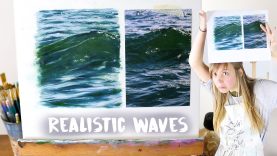
How to Paint Realistic Water | Oil Painting Tutorial
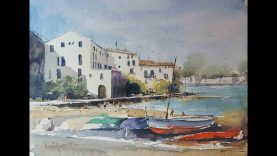
How to make Watercolor seascape painting.
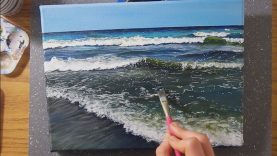
Painting More Waves (acrylic painting timelapse)
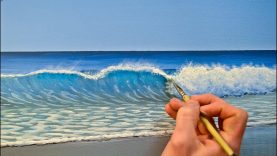
How to Paint a Wave in Acrylics – Video Demonstration

David Dunlop Fog Painting at Prouts Neck
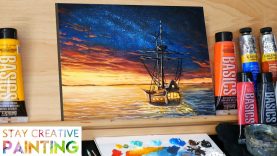
Ship in the Ocean – A Step by Step Painting with Acrylics (Ryan O’Rourke)
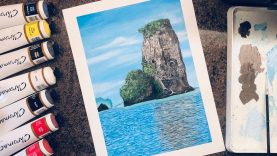
Seascape painting with acrylics / submerged rocks
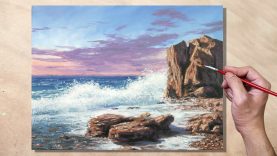
Acrylic Painting Seashore Rocks Seascape

How To Paint Waves/Water! – Oil Painting Tutorial

Art Lesson: How to Paint a Marine Turtle with Water Mixable Oil Paints

Seascape Sunset Panorama Acrylic Painting LIVE Tutorial
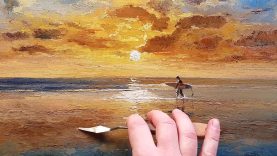
Surfer Sunset – How to – Oil Painting – Palette Knife | Brush – Beach Ocean Waves Dusan
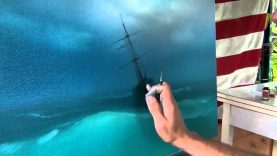
Best lesson. How to paint storm on the sea. How to paint sea waves
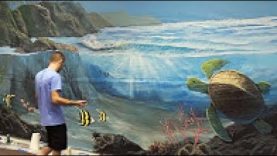
Underwater Ocean Fantasy Mural – Acrylic Painting

Lost at Sea – Full Acrylic Painting Tutorial, Using Only 6 Colors
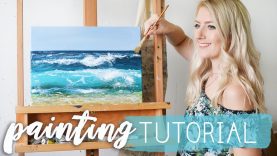
OCEAN PAINTING TUTORIAL | Acrylic Techniques

Watercolor Seascape Tutorial – "Moon Glow"
- How to paint a boat: A step-by-step guide
Painting your boat not only enhances its visual appeal but also protects it from the damaging effects of saltwater, sunlight, and other elements. Whether you have a sailboat, powerboat, or kayak, the principles of boat painting remain largely the same.
Assessing your boat's condition
Before you begin, evaluate your boat's current condition. Inspect the hull for any damage, scratches, or rust that may need to be addressed before painting. Make a list of necessary repairs and tackle them first.
Gathering the right tools and materials
To paint your boat successfully, you'll need a range of tools and materials, including paintbrushes, rollers, sandpaper, masking tape, drop cloths, and, most importantly, the appropriate marine paint.
Preparing the boat surface
Proper preparation is the key to a successful paint job. Start by cleaning the boat's surface thoroughly to remove dirt, grease, and old paint. Sand the surface to create a smooth and clean canvas for the new paint to adhere to.
Applying primer
Priming is a crucial step to ensure good paint adhesion and durability. Apply a marine-grade primer that is compatible with the paint you've chosen. Allow it to dry thoroughly as per the manufacturer's instructions.
Read our top notch articles on topics such as sailing, sailing tips and destinations in our Magazine .
A man taking care of his ship.
Choosing the right paint
Selecting the right type of marine paint is essential. There are different types of boat paint available, such as antifouling paint, topside paint, and bottom paint. Choose the one that suits your boat's needs and your intended use.
Applying the paint
Start by applying the paint to the boat's surface using a paintbrush or roller. Use long, even strokes, working from one end to the other. Be mindful of the weather conditions, as extreme temperatures and humidity can affect the paint's drying process.
Applying additional coats
For best results, you may need to apply multiple coats of paint. Follow the manufacturer's recommendations for drying times between coats. Applying multiple thin coats is often better than one thick coat.
Drying and curing
Allow the paint to dry completely before launching your boat into the water. The curing time can vary depending on the type of paint and environmental conditions. Follow the paint manufacturer's instructions for specific guidance.
Final touches and cleanup
After the paint has dried, remove any masking tape and clean your tools and equipment. Inspect your boat's finish for any imperfections, and make any necessary touch-ups.
Painting a boat requires careful planning, preparation, and attention to detail, but the results can be incredibly rewarding. Not only will your boat look like new, but it will also be better protected against the elements, ensuring many more enjoyable days on the water.
Whether you're a DIY enthusiast or a boat owner looking to maintain your vessel's beauty and functionality, this step-by-step guide on how to paint a boat will help you achieve a professional and long-lasting finish. So, roll up your sleeves, gather your materials, and give your boat the makeover it deserves. Happy painting!
So what are you waiting for? Take a look at our range of charter boats and head to some of our favourite sailing destinations .
Michele Clamp Art
Watercolor paintings, tutorials, and videos
Watercolor Boat Painting Tutorial

Want to paint this watercolor boat painting? Follow the step by step instructions (including video at the end) and see how easy this can be!
I just can’t resist painting boats in watercolor. The colors, the details, the sun and shadow – all come together to make painting these watercolor boats so much fun. In this watercolor boat tutorial I break down all the steps and show you how you can paint this scene. Boat watercolor paintings can seem daunting but if you take things slowly it’s amazing how they come together.
Sign up for updates on classes and free livestreams
Watercolor materials needed.
- Mechanical pencil
- Watercolor paper (I like Fabriano Artistco 140lb cold press)
- Permanent rose
- Vermillion/pyrrole red/naphthol red
- Ultramarine blue
- Cobalt blue/cerulean blue
- Yellow ochre
- Lemon yellow
- Burnt Sienna
- Value Scale
- Color isolator
- Palette/paper towels/water pot
- Small spray bottle of water
Watercolor Boat Drawing

The drawing for this painting is pretty important. Sometimes I won’t put much detail into a drawing and just indicate the main shapes. For instance a landscape with trees can be pretty sparse in the drawing. All the detail and texture goes in by eye with just paint. But for this scene there is a lot going on and we want to indicate the position of a lot of different things.
Using a Grid Helps With Drawing Accuracy
I did this drawing by eye but, if you’re not confident with your drawing, you can grid up your paper lightly with pencil and draw it square by square. That way you can be sure you’re getting everything in the right place. It’s not a foolproof method but it gives you far less room for error. I’ve included a gridded up version of the reference below.

The aspect ratio of the photo is the same as for a 10″x14″ piece of watercolor paper. If you mark your paper into quarters on each side and join them up to make a 4×4 grid you can transfer the drawing more easily onto your paper.
Take Some Time to Make a Plan for Your Painting
Before we dive into the painting it always helps to take a few minutes and plan out what you’re going to do. It can be hard to do this – we want to jump straight in and get those brushes moving and paint splashing around. But a few minutes thought at the start always makes for a better painting. We can spot possible problem areas and make sure we know roughly how we’re going to proceed.
Which Direction is the Light Coming From?
I first make note of where the light is coming from and where the shadows fall. In this case the sun is on our right and the shadows are falling on the left. This is always good to keep in the back of your mind. If the reference is unclear in some areas you can work out how the lights and darks should fall even if you can’t make it out from the photo.
Where are the Lights and Darks?
The next thing I do is note where my lightest lights are and my darkest darks. Once we’ve located these then we know that everything else has to fall somewhere between those areas. In this case our lightest light is the white hull on the left boat. The darkest darks are in the shadow underneath the boats and possibly inside the cabins. I keep this in mind. Nothing else can be darker or lighter than these areas.
Where are the Main Shapes and Values?
This one is trickier but it pays off giving it some thought. Even though there’s a lot of detail going on in this photo I like to break it down into 4 or 5 main value shapes. In this case I would estimate (or measure using our value scale) the value of the following areas
- The hulls of the boats (in light and shadow)
- The cabins of the boats (in light and shadow)
This may seem like a lot to work out ahead of time but getting those big value shapes right is an enormous help getting a scene to hang together and getting it to be convincing.
Identify a Few of the Colors

Doing some test mixes of a few of the main colors can also be a good idea. It’s much easier to do this before the painting. When you’re in the middle of the painting there’s so much going on it’s hard to stop and think about this. It’s a bit like prepping for a recipe. Getting all the ingredients measured out ready ahead of time makes putting a meal together much easier. (Not that I ever really do that – but I should!) In this painting I mixed as I went along but it’s a better idea to try out your color mixes at the start. If you think you can’t remember how you mixed your colors then putting a pencil note next to the swatch is a good idea. It’s doesn’t have to be anything complicated – just a list of the colors is enough.
Watercolor Boat Painting – Finally we Paint!

So let’s start painting. We’re going to paint this in layers and build up the painting from light to dark. We’re first going to block in all the shapes with their lightest colors. Once those are dry we can go back in and add in the darks. This way of working takes a bit of getting used to. As we’re starting with the light colors of all the shapes things won’t start to look three dimensional until quite late on in the painting.

I have many more step-by-step tutorials and videos!
We want things to look flat to start with..
If we put in too much value variation in the early stages then the darks won’t make as much impact when we put those in. In these early stages try and match the color and value as best you can to the reference. And, most importantly, keep these early washes even. Don’t be tempted to try and make things look right at this stage. It takes a bit of faith but once you get used to it it will all make sense.
Keep Going With the Light Values

Keep going across all of the main shapes of the boats. One thing to remember is that we’re putting in the light value of each different shape but these values may vary from shape to shape. For instance, the hull of the red boat is a bright orange-red in the light. The actual value of this is around a 5 i.e. mid-way down the value scale. If we compare this to the beige area above we can see that it’s a little darker. The beige area in the light is around a 7 but it’s still in the light.
Similarly the red stripe on the left hand boat is around a 4 (i.e. darker than a mid-value) in the light. If you have a value scale and a printout of the reference you can measure the values directly. If the color is distracting (and it can be with bright colors like these) squint your eyes and it becomes easier to judge value.
Use the ChromaMagic Tool to Measure Color

Alternatively you can load up the reference in ChromaMagic and click on different areas. It will show you the three components of the color – hue, value and chroma. The color notation is part of the Munsell way of measuring color. It is incredibly useful in painting and makes color very straightforward to analyze.

Paint in the Sea in the Background

The sea in the background goes in next. This is a fairly dark blue and helps to tie the boats in the scene and give us some depth.
As you can see at this point the painting isn’t looking three-dimensional. Don’t panic! This is exactly how it should be looking at this point.
Paint in the Sand Around Your Watercolor Boats

Next we’re going to put in the sand. I really like this bit as we get to put in some texture with our spray bottle. One thing to be careful of – sand isn’t yellow. Or rather it is yellow but a very grayed out low chroma yellow. In this scene it’s a kind of beige so make sure you add in some black to your mix to take out some of the brightness. I’ve made the mistake of painting sand far too bright in color many times. Again mixing a swatch of color beforehand helps a lot as does using ChromaMagic for checking the chroma.
Use a Spray Bottle to Add Texture
While your sand wash is still wet take a spray bottle of water and lightly spritz the surface. If the paper is the right level of dampness the water will add small sparkles and splodges in the paint. It adds some interest and texture to the foreground. This can take a bit of practice to get right. If the paper is too wet the water will just disperse and disappear. If the paper is too dry the water won’t do anything at all.
Watercolor Boat Painting – Add the Sky

Note: I’ve got the order slightly wrong here. I’ve already put in some of the darks on the boats before doing the sky. The order doesn’t really matter. You can put in the sky before the shadows and everything should work out fine.
Let’s put in some sky now. The reference photo doesn’t really have much in the way of clouds and I didn’t really want a big expanse of blue up there. So I’ve invented some cloud shapes. You have a lot of freedom here. Put in some blue around wherever you fancy the clouds to be. While the paint is wet take a clean (very clean) damp brush and soften the edges of the clouds. The blue pigment will diffuse out into the damp areas of paper making lovely soft and convinving clouds.
Watercolor Boat Painting – Second Layer Darks

Now this bit is where the painting starts to come to life. We’re going to put in the shadow sides of the objects and make them look three-dimensional. Adding in these contrasting areas also helps the visual impact of the scene and it will make the image more interesting as well as more realistic.
Don’t Add Color in the Light!
We’ve already painted in the light sides of our objects so we won’t be putting any color in there at all. We’re just going to paint in the shadow colors on mostly the left sides. Make sure your colors are at least a couple of shades darker than your light sides and things will start to take shape. When you get to the insides of the cabins we’re even darker as very little light is getting in there – you don’t need to paint things – just a few dark shapes at different angles will suggest a lot of detail.
Be careful with the shadow on the white hull. We don’t want to go too dark here and keeping that shadow light will really suggest strong sun.
Add a Cast Shadow to Anchor the Boats to the Ground
Finally add some cast shadows on the sand and right at the bottom of the boats. This will make the boats convincingly anchored to the ground.
The Magic Bit – Details on Your Watercolor Boat Painting

By this point you should have something that’s looking pretty three-dimensional. This next bit really adds sparkle and interest to your watercolor boat painting! We’re going to put in some lovely details. Put in the masts and rigging with a small synthetic brush. Make sure they’re not too dark – a mid value gray is plenty dark enough here. The other thing to take care with is not to make your lines too continuous. Leave a few gaps here and there as it will make the masts more convincing than if you carefully paint them in one continuous line.

Continue with the masts and smaller details. Add in a few lines for the railings and the ropes holding the buoys. A few light lines on the white hull will also suggest their structure. I hope everything is looking really good by now!
Flags and Signs

We’re right at the end now. A few red marks for the flags will add a pop of color. The signs on the boat go in with an almost black background. The lettering is suggested with a little opaque white.
Final Thoughts on This Watercolor Boat Painting
If you tried this painting I hope it turned out well. I would love to see your results – please feel free to send them to me. I have also videoed the whole process and you can paint along with the full painting.

Related posts:

2 thoughts on “ Watercolor Boat Painting Tutorial ”
Hi Michele, Kathy Martinez here. I am working with the ColorMagic tool. Love it except for one problem I am having. My monitor is a Cintiq 32 inch display that I have supposedly color corrected with an i1 display gizmo. The colors for the Munsell chips from
Kathy your program don’t come through to match my big book Munsell chips. It is way off. My cintiq screen pretty matches my Ipad. Do you have any suggestions? I have just been finding the chip I have that matches the color swatches from ColorMagic, even though they aren’t the same as described in the program.
Hi Kathy – I replied by email. I was thinking that it may well be hard to match chips directly to the screen. I’m going to try with a setup that I know the colors off and see how it goes. ColorMagic will report the colors in the photo accurately but whether you can match to the display directly may not be possible. Screens give out light and chips only reflect the light so comparing them side by side is going to make the chips always look dark. But maybe there’s something else going on! We’ll see. If it’s fixable we’ll fix it.
Comments are closed.

Ridetheducksofseattle is reader-supported. When you buy through our links, we may earn an affiliate commission. Learn more
How to Paint a Sailboat? Expert Tips and Techniques
Written by Anthony Roberts / Fact checked by Jonathan Larson

Some folks don’t like their sailing vessel’s color, so they may want to learn how to paint a sailboat DIY style. Or maybe the boat needs a retouch for a brand-new and more vibrant look while on the sea.
Regardless of the reason, this easy-to-follow sailboat painting guide will help you splash colors and breathe life into your sailing vessel. The steps are straightforward, although patience is essential.
Let’s start.
Table of Contents
Step 1. Clean and sand the sailboat.
Step 2. apply primer on the sailboat’s hull., step 3. get the paint ready., step 4. apply the paint., sailboat maintenance tips , ways to paint a sailboat.
Painting a sailboat is like coloring any object. It requires preparation, elbow grease, and commitment to complete the job.
Things you’ll need:
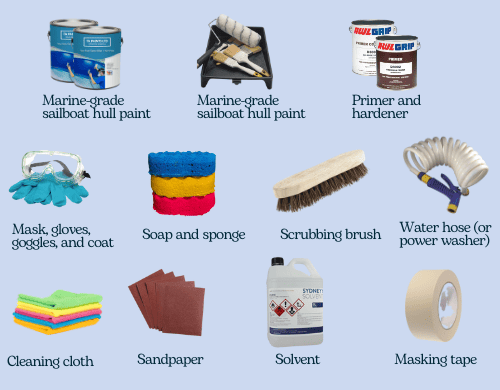
- Marine-grade sailboat hull paint
- Paint roller, brush, and paint tray
- Primer and hardener
- Mask, gloves, goggles, and coat
- Soap and sponge
- Scrubbing brush
- Water hose (or power washer)
- Cleaning cloth
- Masking tape
We understand painting a sailboat can be intimidating for beginners. It can be a fun experience (though tiring), too. So, we prepared a four-step process to make this activity as easy to follow as possible.

Surface preparation is crucial in any paint job. You’ll want a clean, contaminant-free, and smooth surface to ensure the paint adheres to the hull. Here’s how to get your sailboat ready for a paint job.
- Wear your protective gear.
- Check for any signs of damage and repair them accordingly.
- Spray your sailboat clean using a power washer or a hose until the hull is free of dirt, grease, barnacles, etc.
When encountering stubborn objects, scrape them off with a scrubbing brush.
- Create a soapy solution and moisten the sponge. Scrub the boat with the cleaning agent to remove stains.
- Rinse thoroughly.
- Once dry, roughen the boat with 80- to 100-grit sandpaper. Finish the job with 220-grit sandpaper to smoothen the surface.
Pro Tip: Use an orbital sander with a 40- to 80-grit sanding disc for better results.
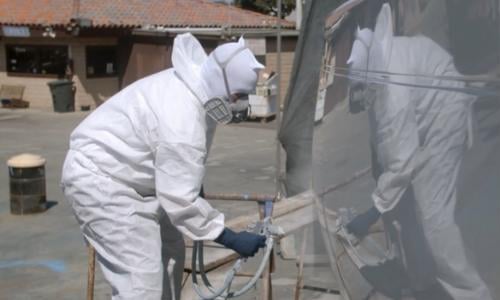
A paint primer is crucial for any painting project, whether by hand or machine. This initial coat gives the boat paint something to “cling” to, ensuring it lasts longer than a primer-less surface.
- Remove all the hardware from the vessel.
- Cover sailboat trims and other elements you wish to leave unpainted. The tape’s straight edge also guarantees more uniform coats.
- Combine the epoxy polymer and hardener following the brand’s instructions.
- Pour the mixture into the paint tray and run the roller to coat it with the priming solution.
- Apply the primer on the sailboat’s hull, covering every square inch.
- Leave the primer to dry for about a day.
- Repeat the primer application three more times, allowing each coat to dry for a day before applying the next layer.
- Lightly sand the primed surface with 300- to 400-grit sandpaper until the boat is smooth.
- Dip a clean rag into a solvent, such as mineral spirits and xylene, and wipe the boat again.
Pro Tip: Use a small paintbrush to apply primer on corners and other areas the paint roller cannot reach.
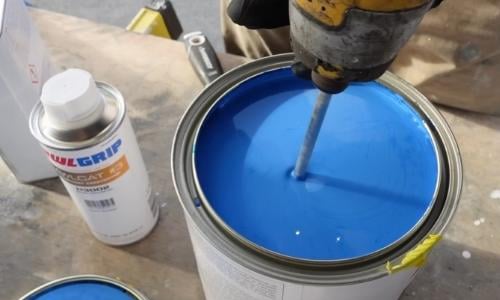
You can either retouch your boat with acrylic paint or a marine-grade variant.
- Acrylic is water-based. Therefore, applying it on a boat might not provide adequate waterproofing, which can result in premature peeling.
However, acrylic paint has the advantage of drying quickly and containing less toxins. To mitigate its drawbacks, you can apply a waterproof coating as the final layer.
- Marine-grade paint is usually the preferred choice, as it’s waterproof, UV-resistant, and salt-resistant.
That said, marine-grade paint is not for easy sailboat painting since it’s a lot harder to apply and requires meticulous handling. In addition, it’s also pricier than acrylic paint.
In either case, please follow the paint manufacturer’s instructions on preparing and mixing the pigment.
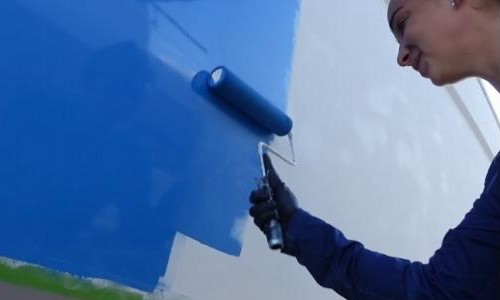
You’re ready to apply paint colors to your sailboat. This step might vary a bit depending on the paint manufacturer. Hence, we highly recommend reading the painting instructions.
- Hose down the area you’re working to settle the dust.
- Pour the boat paint into the tray and lightly dampen the roller with water.
- Immerse half the roller into the paint can and run it several times on the tray for even distribution.
- Paint the sailboat’s hull, ensuring firm and even pressure. Maintain uniform strokes.
- Dip the paintbrush into the paint and remove excess pigment. Paint areas the roller cannot reach.
- Leave the paint to dry following the manufacturer’s recommended curing time.
- Smoothen the surface with 400-grit sandpaper (you can use finer-grit sandpaper). However, you might want to check the paint manufacturer’s guidelines if this step is necessary.
- Apply a second and third paint coating, ensuring the recommended drying time between applications.
Pro Tip: Apply two layers of top coat and antifouling paint to make your DIY sailboat paint job last longer.
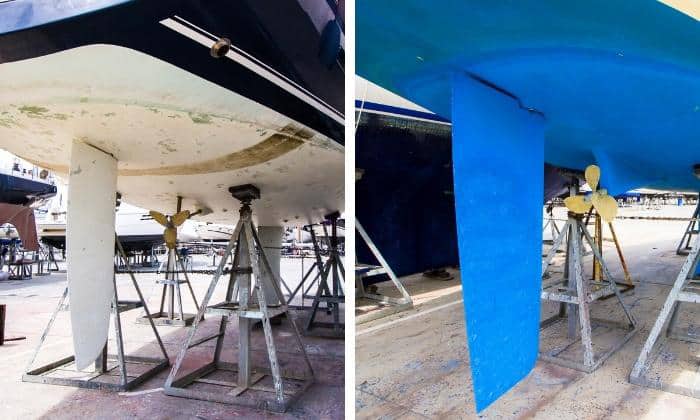
Maintaining a sailboat is crucial because it prolongs its lifespan and boosts its resale value. After all, nobody would want to buy a barnacle-ridden, stain-filled watercraft.
- Wash and clean your sailboat periodically with mild, boat paint-friendly cleaners to avoid removing the paint’s protective coating.
- Use soft water when cleaning the sailboat because hard water can strip pigments off the hull.
- Apply a marine-grade UV protectant or sealer after every wash to leave the sailboat looking pristine and brand-new.
- Repaint a boat with marine-grade pigments at least once annually, especially if you don’t take it out of the water and notice telltale signs of damage or deterioration.
- Choose a sailboat paint to meet your needs. For example, gelcoat paints are ideal for creating a mirror-like finish but require frequent reapplication. Meanwhile, polyester-based topcoat paints can produce gelcoat-like finish but last longer.
Learning how to paint a sailboat offers many benefits beyond extending your watercraft’s lifespan, allowing you to enjoy more leisurely cruises with your loved ones. Painting a boat can be relaxing and rewarding, too. It unleashes creativity and empowers you to be more productive.
However, painting a sailboat takes time, although the process is easy. And if you are a busy bee, you’re better off handing this task to the pros. The results might even be better, except nothing can bring more joy than a project you complete with your hands.

I am passionate about water sports and technical fields, so combining both makes me interested in making contents about boat accessories. With my partner, we went on many trips and sports games together, which led us to think about how we can spread our joys and passions to many people.

Master the Art of Painting a Sailboat on Canvas with These Step-by-Step Instructions
Alex Morgan

Painting a sailboat on canvas can be a captivating and rewarding artistic endeavor. Whether you are an experienced artist or a beginner, this article will provide you with the necessary guidance to create a stunning sailboat painting. We will cover the materials and tools needed, the process of preparing the canvas, sketching the sailboat, blocking in colors, adding details and texture, and the finishing touches to finalize your painting. We will share some tips and tricks to help you along the way. So, let’s dive in and explore the exciting world of sailboat painting on canvas!
Key takeaway:
- Painting a sailboat on canvas allows for creativity and expression: Painting a sailboat on canvas provides an artistic outlet to capture the beauty of the sea and sailing while expressing individual style and interpretation.
- Importance of using the right materials and tools: To achieve desired results, it is important to gather the necessary materials such as brushes, paints, and canvas. Using quality tools ensures better control and precision in creating the sailboat painting.
- Techniques for creating a realistic sailboat painting: Preparing the canvas, sketching the sailboat, blocking in colors, adding details and texture, and applying finishing touches are essential steps in creating a realistic and visually appealing sailboat painting on canvas.
Materials and Tools Needed
“When painting a sailboat on canvas, you will require the following materials and tools:
• Canvas: It is best to select a size that suits your preferences and fits well with your desired composition.
• Acrylic paints: These are highly recommended for their vibrant colors and rapid drying time.
• Paintbrushes: Prepare different sizes and shapes of brushes for detailed work and broad strokes.
• Palette or palette paper: This is necessary for mixing and blending colors effectively.
• Easel or a flat surface: Either of these options is needed to hold the canvas in a comfortable position while you paint.
• Palette knife: Using a palette knife will be helpful in creating texture and adding dimension to your painting.
• Water container: Fill this container with water so that you can rinse your brushes and thin down paints if required.
• Palette cups: It is useful to have palette cups for keeping your paint colors separate and organized.
• Masking tape: Make use of masking tape for achieving clean edges and to protect specific areas of the canvas.
• Pencil or charcoal: Use either a pencil or charcoal to sketch the sailboat and outline the composition.
• Reference photo: To guide you accurately, find a reference image of a sailboat.”
Preparing the Canvas
To prepare the canvas for painting a sailboat, follow these steps:
1. Start with a clean canvas. Use a cloth or brush to remove dust or debris.
2. Apply a layer of gesso to prime the canvas and create a smooth surface for painting. Use a wide brush to evenly spread the gesso.
3. Allow the gesso to dry completely. Check the instructions on the gesso product for specific drying times.
4. Sand the surface. Gently sand the dried gesso with fine-grit sandpaper to remove roughness and create an even texture.
5. Remove any dust. Use a cloth or brush to remove sanding residue from the canvas.
6. Apply a second layer of gesso for a smoother painting surface. Repeat the process of applying and drying the gesso.
To enhance canvas preparation, consider these suggestions:
– Experiment with different textures. Mix sand or other materials with the gesso to create interesting textures on the canvas.
– Use colored gesso. Instead of white gesso, try using colored gesso to add a unique base color to your canvas.
– Prime the sides of the canvas. Apply gesso to the sides of the canvas as well to ensure a cohesive look for your artwork.
Sketching the Sailboat
When sketching the sailboat, follow these steps for a successful depiction:
1. Observe the sailboat closely, noting its shape, size, and proportions.
2. Begin your sketch by lightly drawing the basic outline using straight lines for the hull and triangles for the sails.
3. Add more details, such as the mast, rigging, and distinguishing features.
4. Pay attention to the placement of the sails and their folds to create movement.
5. Continue adding more details like windows, doors, and other elements.
6. Use shading techniques to give depth and dimension, adding shadows for a realistic effect.
7. Once satisfied , move on to painting the sailboat on canvas.
For a more dynamic sketch, try different positions and angles to capture the motion on the water. Practice regularly to improve your ability to accurately depict the essence of the sailboat. Over time, you’ll be able to create beautiful sailboat sketches on canvas.
Blocking in Colors
Blocking in colors is a crucial and fundamental step when painting a sailboat. It is important as it establishes the composition and creates a solid foundation for the artwork. To execute this process effectively, follow these steps:
1. Start by preparing your canvas. Use a medium-sized brush or palette knife to apply a thin layer of gesso or acrylic paint . This will ensure that the surface is smooth and ready for the next steps.
2. The next step is to choose your base colors . Select the main colors for the water , sailboat , and sky . These colors will serve as the starting point for the rest of your painting.
3. Once you have your base colors, begin by blocking in the background . Use broad strokes to apply the paint and establish the basic shapes and tones of the painting. This will give you a general idea of how the final piece will look.
4. Moving on, focus on blocking in the sailboat . Use smaller brushes or a palette knife to add details and refine the shapes of the sailboat. Pay attention to the smaller elements and ensure they are accurately represented.
5. To create smooth transitions and add depth and dimension to your painting, utilize blending and layering techniques . Use a blending brush or, if you prefer, your fingers to blend colors together. Layering paints will provide a richer and more dynamic appearance.
6. Take a step back and assess your work. Make any necessary adjustments to the colors, tones, or shapes. If certain areas require more intensity, consider adding another layer of paint to enhance their vibrancy.
It is important to keep in mind that blocking in colors is only the initial stage of the painting process. As you add further layers and details, your sailboat artwork will come to life.
Adding Details and Texture
Adding details and texture to your sailboat painting brings it to life and creates depth and realism. Here are the steps to follow:
– Mix small amounts of paint to create different shades, tones, and colors. Use various brushes, including small detail brushes, for intricate details.
– Start by incorporating adding details to the sailboat itself. Paint the outline of the boat with a fine brush and add smaller details like windows, ropes, and flags.
– Focus on incorporating texture to the water. Use a palette knife or thick brush to create waves, ripples, and movement. Vary the brushstrokes and direction for a realistic effect.
– Incorporate depth to the sky by layering different shades of blue or other colors. Use a dry brush or sponge to create clouds or a soft, atmospheric effect.
– Continue adding details to surrounding elements like distant hills, rocks, or other boats. Use light and dark shades to create shadows and highlights.
– Evaluate your painting from different angles and make necessary adjustments or additions to enhance the details and texture.
By following these steps and paying attention to details and texture , you can create a captivating and realistic sailboat painting on canvas.
Finishing Touches and Finalizing the Painting
When finalizing a painting, it is important to follow these crucial steps for finishing touches and completing the artwork:
1. Inspect the canvas: Thoroughly examine the painting to identify areas that require touch-ups or corrections, such as smudges, uneven lines, or missed details.
2. Add highlights and shading: Enhance the depth and dimension of the artwork by incorporating highlights in areas that catch the light, as well as shading for creating shadows and contrast.
3. Fine-tune colors: Achieve the desired hues and tones by making small adjustments to the colors. Add minimal amounts of paint to ensure color balance and make any necessary tweaks for achieving harmony.
4. Sign your artwork: Establish ownership and authorship of the painting by adding your name or signature, which adds a personal touch.
5. Protect the painting: Apply a layer of varnish or sealant to safeguard the artwork from dust, moisture, and harmful UV rays. This not only enhances the colors but also provides the finishing touch for a professional appearance.
In addition, consider these final suggestions:
– Step back and appreciate your work, admiring the intricate details and composition you have created.
– Consider framing the artwork using a frame that complements its style and colors, adding an extra touch of elegance.
– Share your artwork with others by displaying it in your home, participating in exhibitions, or selling it to art enthusiasts who truly appreciate your talent.
Remember, these steps and suggestions are vital for putting the finishing touches and finalizing your painting.
Tips and Tricks for Painting a Sailboat on Canvas
When painting a sailboat on canvas, it’s important to follow these tips and tricks in order to enhance your artistic process. First, consider the size of the sailboat and select a canvas size that allows you to capture all the details without feeling cramped. Next, study the colors of the sailboat, sky, and water, and choose a harmonious color palette that reflects the scene realistically or creatively. Before starting the painting, create a rough sketch of the sailboat and its surroundings to help with accurate placement and proportions. Pay attention to unique features like the rigging, mast, and sails as adding these details will bring authenticity and depth to the artwork. Use shadows and highlights to create depth and a three-dimensional appearance for the sailboat, water, and sky. Employ fluid brushstrokes to imply movement and texture in the water, giving the painting a dynamic feel. Experiment with different painting techniques to achieve different effects and textures in your artwork.
I once painted a sailboat on canvas using these tips and tricks, and by carefully considering composition , color palette , and attention to detail, the final painting captured the serenity and beauty of the sailboat gracefully gliding across the sea. The play of sunlight on the sails and the gentle ripples in the water truly brought the artwork to life, evoking a sense of tranquility and adventure.
Some Facts About How To Paint A Sailboat On Canvas:
- ✅ Painting a sailboat on canvas requires a careful selection of colors and brush techniques.
- ✅ Many artists use acrylic or oil paints to create vibrant and realistic sailboat paintings.
- ✅ Creating texture and capturing the movement of water and sails are key elements in painting a sailboat on canvas.
- ✅ Learning how to properly blend colors and create shadows is essential for adding depth and dimension to the sailboat painting.
- ✅ There are various tutorials and online resources available that provide step-by-step guidance on how to paint a sailboat on canvas.
Frequently Asked Questions
How do i cancel contracts on youtube.
To cancel contracts on YouTube, you can follow these steps:
- Log in to your YouTube account.
- Navigate to your Creator Studio.
- Go to the “Channel” tab and click on “Advanced”.
- Scroll down to the “Contract” section.
- Click on the “Terminate” button next to the contract you want to cancel.
- Follow any additional steps or instructions provided to complete the contract termination process.
How can I test new features on YouTube?
If you want to test new features on YouTube, you can do the following:
- Go to your YouTube account settings.
- Scroll down to the “Test Features” section.
- Toggle on the option to “Enable Test Features”.
- Save your changes.
- You will now have access to any new features that are being tested on YouTube.
Where can I find the guidelines and safety information for YouTube?
You can find the guidelines and safety information for YouTube by following these steps:
- Go to the YouTube website.
- Scroll down to the bottom of the page.
- Click on the “Guidelines & Safety” link.
- You will be directed to a page with detailed guidelines and safety information for using YouTube.
What is the NetzDG transparency report on YouTube?
The NetzDG transparency report on YouTube provides information about how YouTube handles complaints related to the Network Enforcement Act (NetzDG). It includes data on the number of complaints received, actions taken by YouTube in response to the complaints, and any other relevant information regarding compliance with the NetzDG.
Who owns the copyright for YouTube until 2023?
Google LLC owns the copyright for YouTube until 2023.
How does YouTube work?
YouTube is a video-sharing platform where users can upload, view, and share videos. It allows content creators to create and upload their videos, which can be accessed by users worldwide. Users can search for videos, subscribe to channels, leave comments, and interact with the YouTube community. YouTube generates revenue through advertising and offers various features and resources to support creators.
About the author
Leave a Reply Cancel reply
Your email address will not be published. Required fields are marked *
Save my name, email, and website in this browser for the next time I comment.
Latest posts

The history of sailing – from ancient times to modern adventures
History of Sailing Sailing is a time-honored tradition that has evolved over millennia, from its humble beginnings as a means of transportation to a beloved modern-day recreational activity. The history of sailing is a fascinating journey that spans cultures and centuries, rich in innovation and adventure. In this article, we’ll explore the remarkable evolution of…

Sailing Solo: Adventures and Challenges of Single-Handed Sailing
Solo Sailing Sailing has always been a pursuit of freedom, adventure, and self-discovery. While sailing with a crew is a fantastic experience, there’s a unique allure to sailing solo – just you, the wind, and the open sea. Single-handed sailing, as it’s often called, is a journey of self-reliance, resilience, and the ultimate test of…

Sustainable Sailing: Eco-Friendly Practices on the boat
Eco Friendly Sailing Sailing is an exhilarating and timeless way to explore the beauty of the open water, but it’s important to remember that our oceans and environment need our protection. Sustainable sailing, which involves eco-friendly practices and mindful decision-making, allows sailors to enjoy their adventures while minimizing their impact on the environment. In this…
- BOAT OF THE YEAR
- Newsletters
- Sailboat Reviews
- Boating Safety
- Sailing Totem
- Charter Resources
- Destinations
- Galley Recipes
- Living Aboard
- Sails and Rigging
- Maintenance
- Best Marine Electronics & Technology

How to Paint Sailboat Decks
- By Tom Zydler
- Updated: March 14, 2013
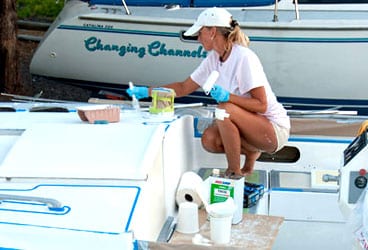
Painting a sailboat
Janet Van Leuwen and Steve Van Wig own a Whitby 42. Looking at their beautiful, well-groomed ketch, you’d never guess it was built in 1982. The name on the stern, Lunacy , may be the only hint of the incredible amount of work that the couple has put into rejuvenating their boat. Bringing the decks and the coachroof top to their present glory was a large part of the project, as these tasks would’ve been on any glass boat more than 25 years old. This is how they did it. And frankly, this is how it should be done.
Before the couple could begin doing any prep work for painting, the deck hardware had to be removed. They needed access to tight spaces where the horizontal deck surface turned into vertical bulwarks, around the masts’ partners, near the windlass base, and so on. (They also removed the chainplates, which needed attention as a separate project.) Out came all stanchions, their bases, various padeyes, winches—anything and everything, in fact, that could obstruct the power sanders required to remove the worn-down, cracking, original nonskid pattern. Steve then used silicon sealant to plug all the fastener holes that would be reused; silicon repels paint, so the fastener locations would be visible when they began reinstalling the hardware.
Donning breathing masks and kneepads, the couple spent days grinding the old surfaces with 80-grit discs. Using thick foam pads on machines running at high rpm prevented any gouging in the laminate. Smaller sanders (both round and square) helped them to negotiate tight turns; at times, they resorted to manual sanding blocks. Working with thickened polyester and epoxy resins, Steve filled several hairline cracks and dings. They then sanded this filler with 80-grit, then 100-grit, and finally 120-grit sandpaper to achieve a smoother surface before vacuuming up all the accumulated dust.
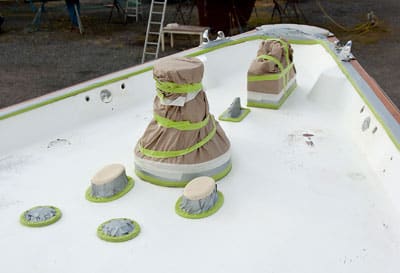
Next, to keep paint drips off teak handrails, the windlass, and the portholes, they masked these with heavy paper and tape. Right after the final wipe with a cleaning solvent, they took two days to roll and brush on two coats of epoxy primer, the base for the final topcoat. Over the next few days, the primed surfaces were sanded with 120-grit paper, followed again by vacuuming and hosing the resulting dust. Afterward, Janet cleaned all the surfaces with non-sticky tack cloths designed for multipart polyurethanes.
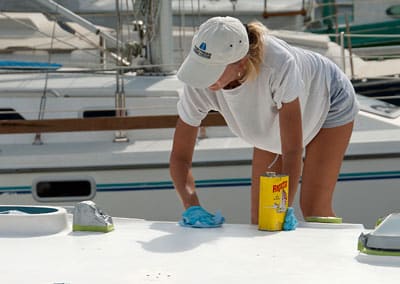
At this juncture, Steve identified and outlined the future nonskid areas, then spent a couple of days taping their inner edges with long-life 3M masking tape. At the corners, joining short lengths of tape on tight curves required meticulous care. After they wiped everything with cleaning solvent, they applied the first coat of multipart polyurethane to all the surfaces outside the future nonskid. Two more topcoat applications followed within allowable, 16-hour intervals. After sanding with 220-grit paper, dusting, using the tack rag, and wiping the solvent, they rolled and brushed on the fourth and final topcoat. The solvent-resistant, ultra-smooth, high-density foam-roller covers and quality brushes delivered the best finish. Working in the hot Florida sun required frequent additions of brushing reducer.
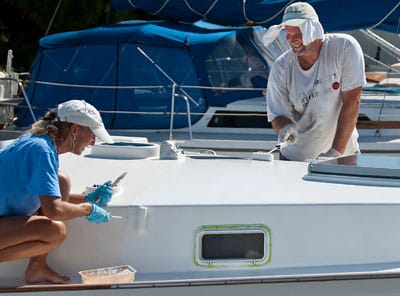
After allowing 48 hours to fully cure, they removed the masking tape. Fresh tape was then applied along the outside margins of the nonskid areas. All was ready for applying the nonskid coats. But first Steve spent a few days experimenting. He mixed his own color tints—too dark, and you couldn’t walk barefoot on the sun-heated deck; too white, and the deck glare was intolerable.
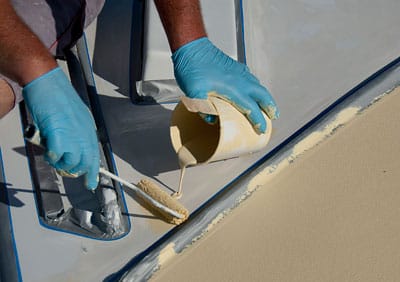
Also, he tested paint combined with various nonskid additives on scrap plywood; very coarse grit could damage human skin if a sailor knelt or fell on deck. He decided to combine equal amounts of coarse and fine grit. Significantly, this mixture prevented the coarse grit from settling down in the paint in lumps. On the big day, Steve and Janet mixed the activator with the paint base in a large container, added the correct nonskid grit, poured in the brushing reducer, and thoroughly stirred it all. After pouring small dollops within a taped area, Steve spread it out with a roller with Janet assisting, adding more paint or grit as necessary. She also wiped up Steve’s occasional paint drips with a solvent-soaked rag. The work went quickly and smoothly, though constant stirring of the paint/grit mixture was absolutely vital.
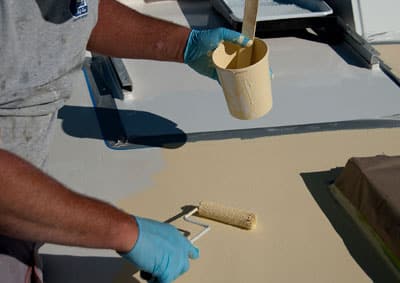
Twenty-four hours passed before heavy, late summer rain rolled in. By then, the paint had cured hard, and the coachroof was finished. They then repeated the whole operation to paint the deck. Nobody said rejuvenating a classic-plastic yacht would be quick or easy. But when the entire project was finished and Lunacy ‘s deck sparkled, the two sailors realized that all their meticulous efforts had been well worth it.
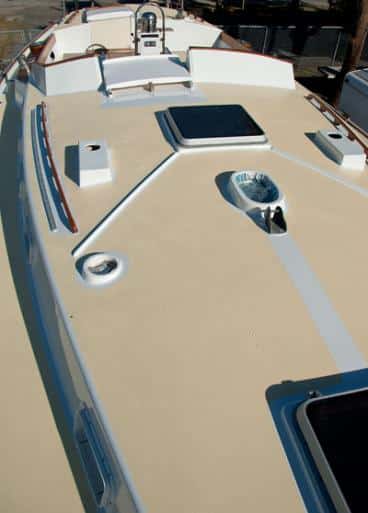
Steps:** 1. In preparation for the job, much of the deck hardware, including the stanchions, had to be removed. The remaining gear was carefully and completely covered and masked. 2. All the fastener holes were filled with silicon sealant, and the couple spent days grinding the old surfaces. Then Janet used a solvent wash to ensure a strong bond with the primer paint. 3. After dings and cracks were repaired and sanded, two coats of epoxy primer were applied. 4. Following another round of sanding, vacuuming, cleaning, and taping, the couple rolled and brushed on a fresh coat of Awlgrip topcoat. 5. After four coats of Awlgrip, it was time for the nonskid. First, Steve experimented with colors and grits. Once under way, he poured on a dollop of pre-mixed paint and spread it evenly. Note the paint stirrer, which was used to prevent the grit from settling. 6. Stirring frequently, to make sure the coverage was even in each masked area, Steve worked quickly and efficiently while Janet addressed small splashes with a solvent-soaked cloth. 7. Voilà! Once the masking tape was removed, the fresh decks fairly glistened.
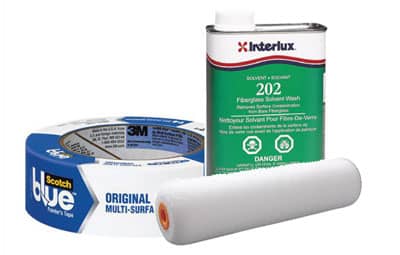
What You’ll Need: • Hook-and-loop sanding discs, sized to fit the sander pads • Sheets of sandpaper of grits 80, 100, 120, 180, 220, and 320 • 3M masking tape in widths of 1/2 inch (No. 256), 1 inch (No. 2090), and 2 inches (No. 225) • Gerson synthetic tack cloths • Roller frames and roller covers, with phenolic cores: ultra-smooth, high-density 4-inch and 6-inch roller covers (available from Home Depot; for the primers and topcoats) and Yellow stripe 3/8-inch nap (from West Marine; for the nonskid paint mixture) • Good-quality varnishing brushes • Cabisil (colloidal silica) thickening agent for making fairing putty with epoxy or polyester resin • Plastic putty knives • Interlux Fiberglass Solvent Wash 202 (for cleaning surfaces) • M.E.K. solvent (for cleaning all brushes) • Disposable paper/plastic pails of various sizes • A dozen wooden paint stirrers • Interlux Epoxy Primekote • Awlgrip topcoat (with Brushing Reducer and brushing converter) • Awlgrip Griptex nonskid additive (fine and coarse grades) • Ryobi and Makita random orbital sanders • Ryobi 6-inch palm polisher (used with a foam pad as a sander in complex spaces) • 3M breathing dust masks, ear protection, and solvent-resistant gloves
Longtime CW contributor Tom Zydler and his wife, Nancy, plan on spending this summer exploring the coast of Labrador aboard their Mason 44, Frances B .
- More: boat maintenance , How To , maintenance
- More How To

3 Clutch Sails For Peak Performance

It’s Time to Rethink Your Ditch Kit

8 Ways to Prevent Seasickness

How To De-Winterize Your Diesel Engine

Bitter End Expands Watersports Program

Sailboat Review: Tartan 455

Miracle in a Bowl

Cole Brauer Completes the Global Solo Challenge
- Digital Edition
- Customer Service
- Privacy Policy
- Email Newsletters
- Cruising World
- Sailing World
- Salt Water Sportsman
- Sport Fishing
- Wakeboarding

Sailboat Bottom Paint: 10 Best Paints

Last Updated by
Daniel Wade
June 15, 2022
If you leave your boat without protection, it's beyond question that it will start attracting several marine organisms such as slime, algae, mussels, barnacle, and seaweed. This will cover the bottom of your sailboat and may negatively affect your boat's speed and fuel efficiency.
This is exactly why you need to apply the best sailboat bottom paint on your boat.
The freedom that sailing and being off land gives you are immense and almost unmatched.
But do you know that having multiple organisms such as algae, slime, barnacle, seaweed, and mussels grow on your boat can throw everything out on the wind and leave you with a very unreliable boat?
These pesky hangers will put a huge dent in your boat's speed, its movement, fuel efficiency, and overall aesthetic.
That's why you need the best sailboat bottom paint to greatly minimize any damage that might be caused to your boat's hull by marine biological growth.
Also known as antifouling paint, bottom paint is essentially a paint or coating that's specifically designed with elements that prevent various marine organisms such as algae, seaweed, barnacles, slime, and mussels from attaching themselves to your boat's hull or any other part of the boat that's below the waterline.
One of the most important elements of bottom paint is the inclusion of a biocide and copper is the most common. This may, however, depend on the type of boat that you have, how, and where you always use it.
But because there's an ocean of bottom paints out there on the market, choosing the best sailboat bottom paint can be an overwhelming task for most of us.
Fortunately, you can always count on us to make it a lot easier for you. We've gone through many bottom paints and we do not doubt that we've selected the most effective, reliable, and best sailboat bottom paint.
Our unbiased selections will not only match your needs and budget but will be available in a variety of colors to complement and augment your boat's visual appeal.
Table of contents
What to Consider when Purchasing Sailboat Bottom Paint
If you're on the market for the best sailboat bottom paint, it's crucial to go for top quality; something that will offer efficiency, top speed, and excellent performance for your sailboat. With that in mind, here are a few things to consider before spending your hard-earned money on bottom paint.
Your Sailing Location
Where are you planning to sail? Is it on a freshwater body or in a saltwater location? This is essential in helping you determine whether to go for a bottom paint that's meant for saltwater, freshwater, or both. It's generally recommended that you go for a bottom paint that will serve you perfectly well in both freshwater and saltwater. This gives you the versatility of sailing anywhere without worrying about marine organisms damaging your boat's hull.
Launch Time and Recoat Time
It's important to keep in mind that bottom paint products have specific launch time limits. The idea here is to ensure that you launch it within the required timeframe and ensure that recoating is done as required. You should, therefore, choose a bottom paint that offers a lengthy launch and recoat time while offering durable protection for your vessel is the right thing to do.
Type of Boat
You should determine whether your boat is made of wood, fiberglass, or aluminum and go for bottom paint that's suitable for that particular surface. Many bottom paints work perfectly with fiberglass but some work great with aluminum or wooden surfaces.
The Fouling Condition
Having a deeper idea of the type of fouling that you might deal with can be crucial when buying the right bottom paint for you. Whether you're dealing with slime, algae, mussel, or any other type of marine organism, knowing the type of fouling you're dealing with will make it a lot easier to pick the best sailboat bottom paint for your vessel.
Best Sailboat Bottom Paint
Rust-oleum marine flat boat bottom antifouling paint.
As one of the most respected brand names in the bottom paint industry, Rust-Oleum is known for producing some of the best sailboat bottom paint and the Marine Flat Boat Bottom Antifouling Paint is one of them. This bottom pain is designed to be suitable for various conditions (both freshwater and saltwater) and is designed with moderate copper that works great if you are environment-conscious.
This bottom paint does an excellent job of offering a protective coating to ensure that your boat is free of all sorts of unwanted marine organisms. You'll love this paint because it is thick and spreads so easily and will not be a problem even if you're a beginner. This bottom paint offers top-notch antifouling properties and is very easy to apply as long as you use a soft brush and mix it carefully. This is a great bottom paint choice that will offer a sleek multi-season finish and ensure that your boat's hull is always awesome and in great condition.
- Easy and simple to apply
- Great for both freshwater and saltwater
- Offers gentle fouling conditions
- Excellent in antifouling
- Offer a sleek and awesome finish
- Quite expensive
- Has a very strong smell that can cause headache
Interlux Fiberglass Bottomkote Antifouling Paint
This is another great brand that is considered as one of the best bottom paint in the sailing world. Even though it's a bit pricey, it offers great features that will ensure that your boat remains in tip-top shape. It is an excellent option if you're looking for a sailboat bottom paint that brings to the fore a unique dual resin approach.
This is a very reliable bottom paint that will not only prevent your boat's hull from the effect of marine organisms but also prevent premature deterioration. It offers an awesome polishing action and is perfecting if you want to discard unnecessary paint buildup. This bottom paint is also very economical and a small quantity will cover a considerable surface area of your boat's bottom.
This is, without a doubt, a superb buy in terms of its practicality and economical nature. It is excellently formulated to prevent marine organisms from damaging your boat and also to ensure that premature wear and tear doesn't exist in your vocabulary.
- It's formulated with a unique dual resin approach to prevent premature wear and tear
- It prevents early decline
- It prevents unnecessary paint buildup
- Great for ensuring that your boat is fuel effective
- Great for all conditions (both freshwater and saltwater)
- It's expensive
- The quantity and size can be misleading
TotalBoat JD Select Bottom Paint
As one of the few bottom paints that's formulated with low Volatile Organic Compounds (VOC), this bottom paint is one of the most cost-effective on this list. With one gallon, you can easily cover about 400 square feet and the application is a breeze since it's even much easier to clean up.
When you purchase this bottom paint, the package will come complete with a pair of latex gloves, a wooden stir stick, an abrasive pad, a metal tray kit, a paint suit, a roller, a painter's tape, and many more. The inclusion of all these accessories makes it a quite cost-effective purchase.
Again, this is one of the most durable bottom paints. Apply it on your boat's hull and you're guaranteed that it will offer excellent protection for the next 18 months. On the downside, this paint is too thick and you'll have to buy an excellent thinner for it to work perfectly.
Nonetheless, this is an ablative bottom paint that is easy to apply and does an excellent job of protecting your boat's bottom for close to two years.
- Perfect for all conditions
- Easy to apply and clean up
- Can improve your boat's speed and fuel efficiency
- Comes with all accessories required for the paint job
- It's one of the best water-based bottom paint products in the industry
- It contains low VOC
- You'll need a top-quality thinner for it to work perfectly
Aquaguard Water-based Antifouling Bottom Paint
An excellent choice for both wooden and fiberglass boats, this is the most perfect bottom point for saltwater conditions. This is a water-based bottom paint that's very easy to apply and clean up (using soap and water) and is formulated with an ablative action that makes it superb for preventing any marine organism that may negatively affect your boat.
This is a bottom paint that is EPA-approved and surpasses the set VOC standards. It has an extended shelf life and offers durable protection for your sailboat. It doesn't contain toxic fumes and is great even for novices. Its drying time is also excellent, so you won't wait for far too long to get your boat out there on the water.
- Excellent for saltwater conditions
- Application and cleaning is very easy
- It's approved by the US EPA
- You don't have to use a primer
- The color selection is limited
- A bit pricey
Pettit Hydrocoat
This is another water-based bottom paint that offers outstanding ablative properties that will protect your boat from marine organisms throughout the seasons. It offers good value for money and is easy to apply and clean up with just water and soap.
We're talking about a bottom paint product that will protect your boat's hull for months on end. You also do not need a full tank of the paint to complete the job. With just a single gallon, you can be sure to complete an area as big as 430 square feet.
This is also one of the few bottom paints that can perfectly prevent your boat from damage when being trailered, launched, or beached. More importantly, it's not irritating to the nose and eyes because it has low VOC.
- It will dry in 3 hours
- It's easy to apply and clean up
- It offers multi-season protection
- It's not irritating to the eyes and nose
- It's quite economical
- May not be the best in antifouling
- You have to apply at least two coats
SEA HAWK PAINTS Aluminum Boat Paint
One of the best aluminum boat paints in the market, this bottom paint is formulated to offer quick-dry corrosion-blocking, high-solid features. This bottom paint is specifically manufactured to be used in aluminum boats and doesn't require the addition of any primer.
While it doesn't have an antifouling feature, it stands out and can be used both below and above the waterline as it is risk-free and free or chromate. It is also formulated to offer a unique dual resin approach and can be used both as paint and a primer at the same time.
This is a great paint for both freshwater and saltwater conditions and can be applied as a primer or topcoat on a fiberglass boat. This is an excellent sailboat boat bottom paint that's worth every coin as it is practical, versatile, and can combat both rusting and lifting.
- The application and cleanup process is easy
- Great for both freshwater and saltwater conditions
- It doesn't require a primer
- Can be used as primer or topcoat in fiberglass boats
- Can prevent rusting and lifting
- It has quick-dry and anti-corrosion features
- Can produce deadly fumes
TotalBoat Spartan Boat Bottom Paint
If you've been looking for a practical, reliable, and cost-effecting bottom paint that will offer durable performance and protection, the Spartan Boat Bottom Paint. Perfect for both freshwater and saltwater, it can be perfect for protecting your boat and ensuring that it is fuel-efficient and reliable.
This bottom paint is formulated with advanced copolymer ablative to ensure that it doesn't deteriorate instantly. This is a very dependable bottom paint that will serve you perfectly throughout the year and will ensure that your boat easily defies fouling while reducing unnecessary buildup and sanding on your boat.
This is a very adaptable bottom paint that not only offers great value for money but is very easy to apply. More importantly, it is very durable and will protect your vessel for at least 12 months on any type of water.
- Great for all types of water
- It offers a very durable protection
- Available in a wide variety of color selection
- Offer a visually appealing abrasion-proof finish
- The included accessories aren't up to the right quality
To this end, we must put a lot of emphasis on the importance of having the right bottom paint for your boat. In addition to being an antifouling agent, bottom paint will significantly increase the fuel efficiency of your boat and ensure that it performs optimally at all times. Of course, you do not want to diminish your sailing escapades or have your nice and beautiful vessel damaged by marine organisms just because you didn't apply the right sailboat bottom paint. If you're unsure how to proceed, here's how to paint a sailboat.
Related Articles
I've personally had thousands of questions about sailing and sailboats over the years. As I learn and experience sailing, and the community, I share the answers that work and make sense to me, here on Life of Sailing.
by this author
Repairs and Maintenance
Sailboat Upgrades
Most Recent

What Does "Sailing By The Lee" Mean?
October 3, 2023

The Best Sailing Schools And Programs: Reviews & Ratings
September 26, 2023
Important Legal Info
Lifeofsailing.com is a participant in the Amazon Services LLC Associates Program, an affiliate advertising program designed to provide a means for sites to earn advertising fees by advertising and linking to Amazon. This site also participates in other affiliate programs and is compensated for referring traffic and business to these companies.
Similar Posts

How To Choose The Right Sailing Instructor
August 16, 2023

Cost To Sail Around The World
May 16, 2023

Small Sailboat Sizes: A Complete Guide
October 30, 2022
Popular Posts

Best Liveaboard Catamaran Sailboats
December 28, 2023

Can a Novice Sail Around the World?
Elizabeth O'Malley

4 Best Electric Outboard Motors

How Long Did It Take The Vikings To Sail To England?

10 Best Sailboat Brands (And Why)
December 20, 2023

7 Best Places To Liveaboard A Sailboat
Get the best sailing content.
Top Rated Posts
Lifeofsailing.com is a participant in the Amazon Services LLC Associates Program, an affiliate advertising program designed to provide a means for sites to earn advertising fees by advertising and linking to Amazon. This site also participates in other affiliate programs and is compensated for referring traffic and business to these companies. (866) 342-SAIL
© 2024 Life of Sailing Email: [email protected] Address: 11816 Inwood Rd #3024 Dallas, TX 75244 Disclaimer Privacy Policy

IMAGES
VIDEO
COMMENTS
Hello my creative friends! In this acrylic painting tutorial we will go step by step to learn how to paint a sailboat in the ocean. Thank you to my awesome p...
After you have finished with the 600 grit sandpaper, it is time to move on to 800, then 1200. This process is important so you will be painting on as smooth a surface as possible. It is then a good idea to wipe the surfaces of the boat down with a damp cloth to remove any of the dust and flakes of metal/wood.
In today's acrylic painting tutorial we paint a sailboat out on the ocean at sunset. This relaxed painting lesson is done in real time and will cover the ste...
Hey guys here is a super Fun and EASY watercolor tutorial for you to try abstract sailboats!! I go over this step by step- lots of fun with wet on wet techni...
Consider these steps: 1. Choosing the Right Primer: Select a primer that is compatible with the type of paint you'll be using and suitable for the boat's material. 2. How to Apply Primer: Follow the manufacturer's instructions and apply the primer evenly across the entire surface of the sailboat.
Blocking in the background is an important step in painting a sailboat with acrylics. It establishes the composition and sets the tone for the rest of the painting. Here is a step-by-step guide on how to block in the background: 1. Choose the colors for the background based on the atmosphere and mood you desire.
Practical Steps for Painting a Sailboat. Step 1. Give the sailboat a thorough cleaning. Step 2. Start sanding the hull's surface. Step 3. Prepare the primer, then apply it. Step 4. Prepare the paint, then start applying the topcoat and antifouling coat.
This watercolor sailboat takes less than 10 minutes to paint but includes simple techniques to inspire and spark creativity. This is a great tutorial for beginners, too! Watercolor Sailboat Step by Step. 00:00 - Intro. 00:32 - Color mixing. 01:06 - Painting the sail boat.
Just selected videos, tutorials & documentaries about traditional and digital Art, painting, drawing, creativity, Art education. Just the highest quality video content for all figurative artists, from beginners to advanced practitioners.
Whether you have a sailboat, powerboat, or kayak, the principles of boat painting remain largely the same. Assessing your boat's condition. Before you begin, evaluate your boat's current condition. Inspect the hull for any damage, scratches, or rust that may need to be addressed before painting. Make a list of necessary repairs and tackle them ...
Watercolor Boat Painting - Finally we Paint! Paint the cabins in the lightest value. Continue with the light colors. More light colors. So let's start painting. We're going to paint this in layers and build up the painting from light to dark. We're first going to block in all the shapes with their lightest colors.
Mar 27, 2020 - Explore Modern Art Gallery's board "sailboat painting", followed by 1,599 people on Pinterest. See more ideas about sailboat painting, painting, canvas painting.
In today's acrylic painting tutorial we paint a seascape depicting a sailboat out on the reflective water. This relaxing painting lesson is completed for the...
Pour the boat paint into the tray and lightly dampen the roller with water. Immerse half the roller into the paint can and run it several times on the tray for even distribution. Paint the sailboat's hull, ensuring firm and even pressure. Maintain uniform strokes. Dip the paintbrush into the paint and remove excess pigment.
Painting a sailboat on canvas allows for creativity and expression: Painting a sailboat on canvas provides an artistic outlet to capture the beauty of the sea and sailing while expressing individual style and interpretation. Importance of using the right materials and tools: To achieve desired results, it is important to gather the necessary ...
Then Janet used a solvent wash to ensure a strong bond with the primer paint. 3. After dings and cracks were repaired and sanded, two coats of epoxy primer were applied. 4. Following another round of sanding, vacuuming, cleaning, and taping, the couple rolled and brushed on a fresh coat of Awlgrip topcoat. 5.
Paint these boats and the swirling sea with Feliks. Whether you're a beginner or an experienced painter, this acrylic painting is a good practice for you. Learn how to mix and blend colors for the background, simple abstract design for the sea, and easy acrylic painting for the boat. Watch this painting video of swirling sea and boats now!
Oct 28, 2016 - Explore Tom Zimmerman's board "sailboats to paint" on Pinterest. See more ideas about painting, sailboat painting, sailboat art.
Rust-Oleum Marine Flat Boat Bottom Antifouling Paint. As one of the most respected brand names in the bottom paint industry, Rust-Oleum is known for producing some of the best sailboat bottom paint and the Marine Flat Boat Bottom Antifouling Paint is one of them. This bottom pain is designed to be suitable for various conditions (both ...
This video shows how to paint a sailing boat in watercolor. It´s simple and easy, for beginners. Get my drawing book: http://amzn.to/1K7L8EdFollow my Instagr...
Check out our sailboats to paint selection for the very best in unique or custom, handmade pieces from our ceramics & pottery shops.
Get this FULL SERIES here: https://www.offcenterharbor.com/yt-boat-paint-2204/Get a grip on how to paint a boat — before you head off to the marine paint sto...
sockodough on March 18, 2024: "Beret Hat, 2024 Bliss, 2024 It's mine, 2024 Paper boat, 2024 Mixed media on linen 12 x 9 in 30.5 x 22.9 cm Walnut Frame #painting..."
David Singer at Rocky Point Boat Worx discusses how he preps a boat for a fresh coat of paint using the roll and tip method. After that the paint and top coa...